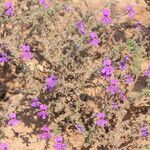Stout dwarf twiggy shrublet up to 150-500 mm tall, branches crowded with closely leafy brachyblasts, young parts and pedicels glandular-pubescent, hairs up to 0.2-0.25 mm long, scattered glistening glands as well. Leaves opposite and decussate, very close-set, mostly up to 1-1.5 x 0.8-1 mm, ovate or cuneate or sometimes the lowermost on each brachyblast up to 1.8-3 x 0.5-0.8 mm, oblong, all thick-textured, apex acute, base broad, margins entire, revolute, upper surface glabrous, lower with big glistening-glands in centre of leaf, margins glabrous. Flowers solitary in the axils of the primary leaves on all the branchlets. Pedicels c. 6-13 mm long. Calyx tube 0.2-0.3 mm long, lobes 2-3.3 x 0.5-0.8 mm, ± oblong, acute, tips often recurved, glandu lar-puberulous, hairs up to 0.1-0.2 mm long, glistening glands as well. Corolla tube 7-10 x 1.8-2 mm in throat, cylindric, abruptly expanded near apex, limb c. 7.5-18 mm across lateral lobes, posticous lobes 3-8 x 2-5.5 mm, anticous lobe 3-8 x 2-5 mm, cuneate-oblong, often retuse, glandular-puberulous outside, hairs up to 0.1-0.2 mm long, glistening glands as well mainly on backs of lobes and swollen part of tube, broad transverse band of clavate hairs in throat, lobes bright purple-blue or deep mauve, yellow in throat, red median streak at base of each lobe. Stamens: posticous filaments 1-1.4 mm long, anthers 0.7-1.1 mm, anticous filaments 0.6-1 mm long, anthers 0.4-0.8 mm, all filaments minutely puberulous. Stigma 0.2-0.3 mm long. Style 4-7 mm long. Ovary 1.3-1.8 x 0.75-1 mm. Capsules 4.5-7 x 2.5-3 mm, scattered glistening glands, sometimes ± confined to sutures, minute glandular hairs as well near apex. Seeds c. 0.25-0.5 x 0.2-0.3 mm. Flowering in all months.
More
Stout, twiggy, dwarf shrub, up to 500 mm high; branches with closely leafy short-shoots. Leaves small, mostly up to 1.5 x 1.0 mm, close, 4-ranked, ovate, cuneate or oblong, thick, acute, entire, revolute. Flowers single, axillary. Pedicels up to 13 mm long. Calyx: tube up to 0.3 mm long; lobes ± oblong, acute with stalked glands. Corolla: tube up to 10 mm long; lobes cuneate-oblong, often retuse, purple blue or deep mauve with central streak at lobe base, throat yellow. Flowering time all year.
Glandular-hairy shrublet to 50 cm. Leaves small, imbricate, leathery, entire. Flowers axillary, tube inflated above, purple to mauve with red, median streaks and yellow throat.

